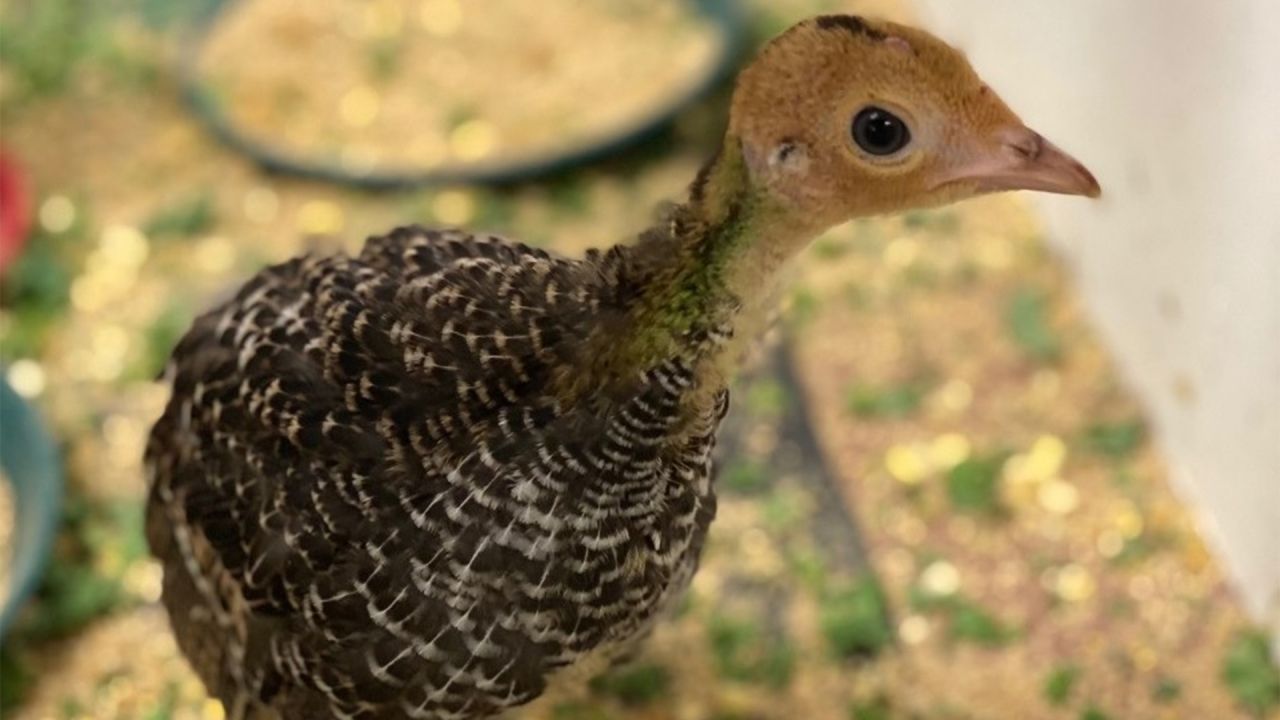
Two-week–old ocellated turkey poult in its brooder at the Bronx Zoo’s World of Birds.
(Photo credit: Chuck Cerbini/WCS)
For Americans, the Thanksgiving holiday serves as an opportunity for family and friends to gather, reflect on the year that’s been, and offer gratitude to each other. Indeed, when President Abraham Lincoln officially declared Thanksgiving a holiday in 1863, he did so in gratefulness of the recent Union Army victory at Gettysburg.
Over the years, tradition has endured. Family, friends, parades, pies, and football, among other things, have all become familiar elements of our fourth Thursday in November. However, the centerpiece of the Thanksgiving tradition remains the scrumptious turkey on the dinner table. Whether it’s roasted, smoked, or deep-fried, the turkey is arguably the most iconic part of the Thanksgiving tradition.
This year, we all could lend gratitude to nature by learning more about this big bird’s life and natural history. The turkeys on our dinner plates were first domesticated from the wild turkey over 2,000 years ago in Mexico. The wild turkey is a symbolic North American species found from the southernmost parts of Canada all the way to central Mexico. It lives in all 48 contiguous U.S. states and has even been introduced to Hawaii. There are six subspecies of wild turkey currently recognized.

Chuck Cerbini with an ocellated turkey at the Bronx Zoo’s House of Birds. The “ocellated” in the species’ common name refers to the ornate pattern of iridescent colors on the tips of the birds’ tail feathers. (Photo credit: Julie Larsen Maher ©WCS)
These subspecies differ chiefly in geographic range and feather coloration. For example, one particular subspecies of wild turkey is a resident of peninsular Florida while another can be found in the Rocky Mountains. And while a nearly ubiquitous species throughout its North American range today, wild turkey populations were once critically low but rebounded due in large part to reintroductions.
The wild turkey as a species is placed in the Galliformes order along with relatives like pheasants, grouse, quail, and partridge. In this broad grouping, however, the wild turkey may be considered somewhat evolutionarily distinct and only one other species shares its genus: the ocellated turkey of the Yucatan Peninsula.
The ocellated turkey certainly recalls its closest relative to the north, but stands out due to several unique physical features, the most notable of which may be size. While the wild turkey is the heaviest representative of the Galliformes order, weighing up to 20 pounds, the ocellated turkey is about half that size at best.
The “ocellated” in the species’ common name refers to the ornate pattern of iridescent colors on the tips of the birds’ tail feathers. The glimmering copper and shimmering blue-greens adorning the top of these feathers form an eyespot, the zoological term for which is “ocellus.” This beautiful feature is absent on any of the subspecies of wild turkey.
Not to be outdone by the “ocelli” of the ocellated turkey’s tail feathers, the wild turkey has its own distinctive physical characteristic: a beard that is actually a tuft of bristle-like feathers originating from the breast. Ultimately, the ocellated turkey may win the battle of bodily ornamentation with orange nodules present on the bare skin of the head and neck that brighten and enlarge during the breeding season.
Despite some physical differences, the two species do share some similarities. Both have a snood, a fleshy protuberance that hangs over the beak and engorges during the breeding displays of males. Additionally, both wild and ocellated turkeys are gregarious, occurring in large flocks while foraging on the ground to support similar omnivorous diets of invertebrates, seeds, leaves and fruits.
Unlike its cousin, which presently enjoys a robust population size, the ocellated turkey is currently considered Near Threatened by the International Union for the Conservation of Nature (IUCN), with an estimated breeding population of only 20,000-50,000 birds. This current status is due mostly to hunting and habitat loss or alteration.
While becoming increasingly rare in its native range, the ocellated turkey population in North American zoos has also dwindled. Because of this, the Bronx Zoo maintains a breeding group of ocellated turkeys, which may be seen in the zoo’s World of Birds building. The Bronx Zoo Ornithology Department is working to build a sustainable population of this rare species. During the breeding season of 2020, the Ornithology team successfully raised seven young poults to adulthood.
As we celebrate Thanksgiving, let us remember the wild turkey and its closest relative, the ocellated turkey. Both magnificent and bizarre, these two species effectively symbolize why we should be thankful for nature and its infinite variety.
